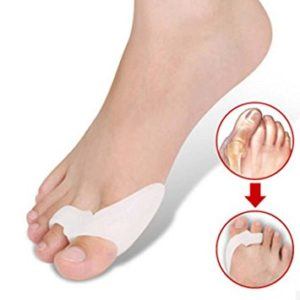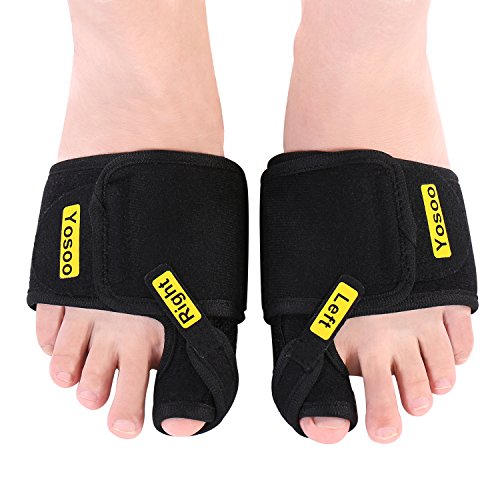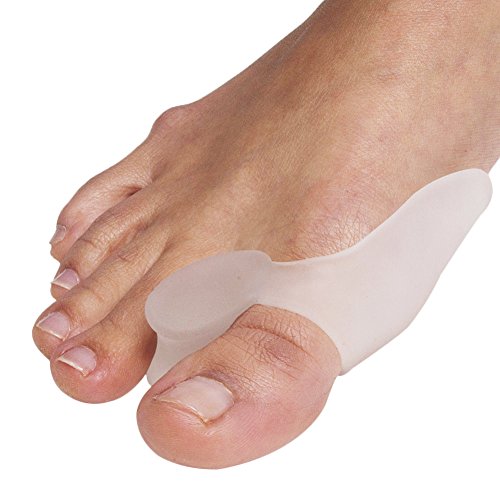Do Toe Separators Really Help Bunions?
 Toe separators are incredibly popular right now, and are recommended by yoga instructors, dancers, and basically anyone on the Internet. They are inexpensive, come in a variety of styles, and promise to fix all your foot problems. Companies claim their toe separators can help repair hammertoes, mallet toes, plantar fasciitis, and even bunions.
Toe separators are incredibly popular right now, and are recommended by yoga instructors, dancers, and basically anyone on the Internet. They are inexpensive, come in a variety of styles, and promise to fix all your foot problems. Companies claim their toe separators can help repair hammertoes, mallet toes, plantar fasciitis, and even bunions.
But do they really work?
After doing some research on different types of toe separators, I was curious to see what the medical community has to say about them. While many products available online claim to be endorsed by podiatrists, I know that companies will say anything to endorse a product.
I also know that people who have bunions are willing to do almost anything to get rid of them. Since surgery is expensive and not always recommended, people have to turn to at-home treatments to alleviate their pain and suffering.
Toe separators seem like both an easy and logical way to realign the toes over time. However, I’ve also heard they are a waste of time when treating bunions. So I set off in search of more information before considering purchasing a toe separator. Here is what I found out!
Your family history may be to blame for your bunions.
I’ve done a lot of research on what causes bunions, and while some people develop bunions as a result of bad shoes or foot injuries, many people will get them no matter what they do.
Bunions are formed as the result of misaligned feet and imbalanced walking – something you likely inherited from your parents. Doctors will tell you that bunions often run in families, though there is no one clear reason as to why. For many, they simply inherited their parent’s poor foot structure, weak ankles, or bad posture.
If this is the case, a toe separator isn’t going to cure your bunion problem. It might help you prevent them from worsening, or alleviate some of the pain, but if you have a family history of bunions, you’re pretty much doomed to get them no matter what.
The medical community does not endorse toe separators.
Before taking on any bunion treatment, it’s a good idea to talk to your doctor or podiatrist to discuss treatment options. However, many people don’t do that and just buy whatever treatment sounds like it’ll work. So I decided to do some digging around to see if I could find significant evidence that these products work. What I found was…not promising.
The American Podiatric Medical Association does say that using a toe separator between the big toe and second toe can help treat the pain of a bunion. However, they do not say using a toe separator will fix your bunion. Instead, they suggest going to your doctor as early as possible so they can help you find a treatment that will work.
The other problem I found in my research is that, well, there hasn’t been much research done on the long-term effects of using toe separators. A study done in 2008 said that after using toe separators for 3 months, subjects found toe separators worked well to manage their pain, but did almost nothing to actually realign the bones of the foot.
One doctor who does endorse toe separators is Dr. Ray McClanahan from Northwest Foot and Ankle. He developed at toe separator called Correct Toes to help people fix their feet. He claims the device works a lot like braces on your teeth – gradually returning your toes to their original, natural position on the foot. He also cites several studies, articles, and books dedicated to the connection between foot problems and our shoes.
So if you are looking to use a toe separator to help with pain, it’s a great option. However, if you think using one will magically cure a bunion, you may be out of luck.
Early intervention is key in fixing bunions.
 Using a toe separator to manage your bunion pain is great, but it’s too tempting to use that in place of getting proper medical treatment. The longer you wait to treat a bunion, the worse it can get. Not only will the bunion get bigger, but according to Dr. Neal M. Blitz, it can affect your other toes as well. Bunions can lead to hammertoes, overlapping toes, and other unsightly problems.
Using a toe separator to manage your bunion pain is great, but it’s too tempting to use that in place of getting proper medical treatment. The longer you wait to treat a bunion, the worse it can get. Not only will the bunion get bigger, but according to Dr. Neal M. Blitz, it can affect your other toes as well. Bunions can lead to hammertoes, overlapping toes, and other unsightly problems.
Whether your bunion is large or small, get it checked out by your doctor. They may suggest using a toe separator or nighttime splint to help with the pain, but ultimately you need to do more than that to truly fix the problem.
Once you have a bunion, you cannot get rid of it – you can only do your best to keep it from getting worse. A toe separator may help you hold off on surgery, but if not treated, it eventually will need to be surgically fixed.
You get what you pay for.
If you are still interested in buying a toe separator, or your doctor recommended one, don’t cheap out on it. I know it’s tempting to spend $6 on a toe spreader that looks pretty and claims to work just as well as a higher-quality separator or splint.
My advice would be if you were looking to buy a toe separator, do your research and find one that works for your needs and budget. Here are a few types of toe separators I’ve found that I think would be worth checking out:
Recommended Toe Separator for Bunions
Yosoo Health Gear Bunion Corrector Splint
 This is a splint for your big toe that you can wear around the house, while you’re sleeping, or after having bunion surgery.
This is a splint for your big toe that you can wear around the house, while you’re sleeping, or after having bunion surgery.
It won’t fix your bunion, but it will help keep the toe in the proper place to relieve pain after a long day of wearing shoes.
At $40/pair, it seems expensive, but the quality is amazing and it will last you for years.
Flyen Bunion Corrector & Bunion Relief Protector Sleeves Kit
 This is a 7-piece kit that includes a bunion sleeve you could easily wear inside shoes, two sets of small toe separators, and an exercise band to strengthen the muscles around your big toe to help realign it and ease pain.
This is a 7-piece kit that includes a bunion sleeve you could easily wear inside shoes, two sets of small toe separators, and an exercise band to strengthen the muscles around your big toe to help realign it and ease pain.
For only around $20, this is a great value and has a lot of options to personalize your treatment.
Dr. Rogo 2 Big Toe Separators for Bunions
 If you are looking for a simple separator to go between you big toe and second toe, this is a good option.
If you are looking for a simple separator to go between you big toe and second toe, this is a good option.
You could easily wear this in wide-width shoes, and because it wraps around the big toe, it should stay in place all day.
Again, it won’t cure your bunion, but it’ll keep the bones in their proper place throughout the day, which will help with pain and soreness after a long day on your feet!
Conclusion
After doing a lot of research on the ins and outs of bunions, and comparison-shopping online for toe separators, I’ve come to a major conclusion:
Toe separators DO help bunions, but they DO NOT cure bunions.
If you are looking for pain relief throughout the day, or while sleeping at night, a toe separator might be a good option for you. There are great products out there you can wear inside your shoes or around the house that can really help. Research has shown that using toe separators does help significantly with pain management, so if you are using it for that purpose, you won’t be disappointed.
However, if your bunions are too far advanced or too painful, surgery is going to be the only option to really fix the problem. Medical research has shown that toe separators don’t repair damage or realign bones, even if worn for months at a time.
